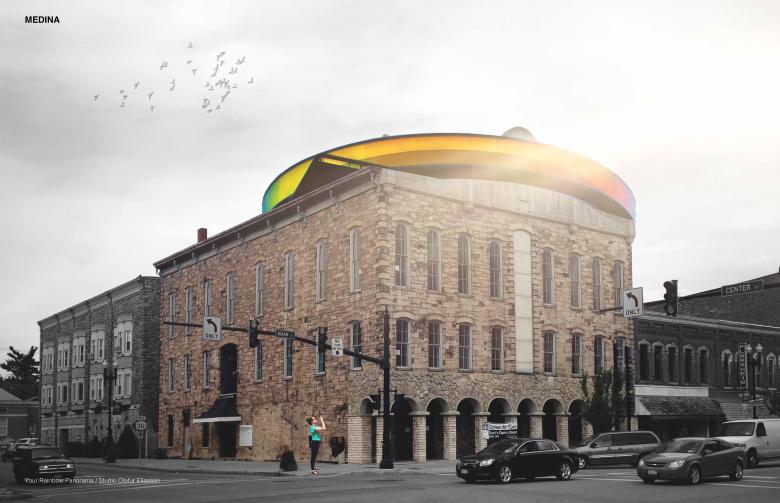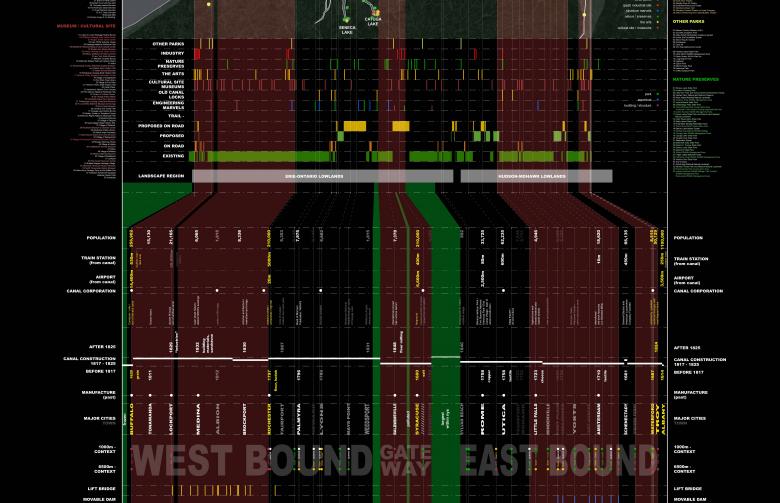New York State Canal System
New York, USA
- Architects
- COLLECTIVE
- Location
- New York, USA
- Client
- New York Power Authority
- Team
- Betty Ng, Ivy Ip, Juan Minguez, Katja Lam, Kimberley Lau, Ray Lau, Sanny Ng, Wingyi So
“A Cultural Tourism Masterplan for the New York State Canal System”
Phase 1: Finalist Out Of 145 International Entries For The Competition “Reimagine The Canal”
American Institute of Architects (AIA) Merits Award 2020 for Urban Design, HK Chapter
THE MASTERPLAN
In 1817, when America was merely 41 years old, construction began on the 363-mile canal linking the Great Lakes to the Hudson River and New York City under the grand vision of New York State Governor, DeWitt Clinton. Against all doubts and skepticism, the Erie Canal came into service ahead of schedule and on budget in 1825, shortening the trip from Albany to Buffalo from 6 weeks to less than 1 week. The system was so popular it managed to pay off its construction fee by collecting toll fees within 10 years. The scale and logistic difficulties set the Erie Canal apart as great achievement of American ingenuity and spirit. It is the major spine that intersects with the Oswego Canal, the Cayuga-Seneca Canal, and the Champlain Canal to become the 524-mile network of New York State Canal System.
From a man-made ditch to engineering marvels, the Erie Canal continued to flourish and became a commercial, cultural, and social highway that served as the internet of its time to accelerate movement of people, goods, and ideas in both directions. It acted as gateway to welcome influx of immigrants and new ideas from all over the world. Many towns and cities along the Erie Canal became major hubs to nurture social and religious movements like the Mormon in Palmyra and the Shakers in Schenectady. First women’s right convention took place in Seneca Falls. The canal system was part of the Underground Railroad to support slave liberation. Not only did the canal system changed national and international trade in the United States forever, it also helped shape New York City into the powerful economic hub in the world. The global ramifications of the New York State Canal System that supported the United States to grow from a third-world country to one of the richest nations in the world are worth celebrating for.
200 years later, the New York State Canal System remains and intertwines with Amtrak’s Empire Service Route, the Empire State Trail, and New York State Thruway (I-90) to form an infrastructural corridor where nature coexists with man-made Interventions and merges with culture to celebrate its heyday with new opportunities.
Our research on the New York Canal System results in a chart that illustrates different sets of data we have collected and highlights the characteristics of the New York State Canal System. It is an enormous data bank that serves as a guide map that allows us to observe the past, the present and the potential future through relationships, adjacencies, latencies, and opportunities. We use is as a “Character Map” - a tool to determine possible points of interventions.
We believe that a project of this scale traversing the whole of New York State needs to be first examined with an overall master planning scale. However, to illustrate the intention of the program initiatives, physical concepts are needed to evoke an understanding. Therefore, in our proposal, we focused on the overall New York Canal program initiatives and zoom into the 24 sites. For each of the 24 sites, we include 1 to 2 image(s) to render the potential state of an imaginary or appropriated intervention, a diagrammatic plan illustrating the initial concepts, and an aerial map showing interventions in context.
24 SITES
Known as the mother of cities, the Erie Canal gave birth to many settlements all along its shore. Villages along the canal boomed into dynamic cities. It helped the nation to develop a root beyond its frontier by connecting east and Midwest. Prosperity dispersed through navigations of the water body. The Erie Canal became the foundation of many canal towns and cities where commerce and manufacturing industries came into fruition. Today, 80% of the upstate population still live within 25 miles of it.
The gravitation of populations along the Erie Canal drives the development of various infrastructural networks across New York State. Majority of airports in New York State are serving cities located right along New York State Canal System. As we sort the sizes and populations of the cities along the canal system, we can easily identify Albany, Syracuse, Rochester, and Buffalo as the major hubs, all within 1.5-hour flight to New York City. These four major magnets are also connected by Amtrak’s Empire Service Route with 1.5-to-2-hour train rides in between and with train stations located within proximity to the city centers.
In between these four major cities, we have identified 20 more points of interventions along the canal system and New York State Thruway (I-90) to create a rhythm of 20-to-30-minute driving or 1-to-2-hour cruising intervals, marking and conducting the journey through the Erie Canal. Aside from looking at utilizing the existing infrastructural systems to activate the points of interventions, we also incorporate the existing and proposed Empire State Trail as a mean of access as well as potential catalytic attractions. These 24 sites are carefully selected ( as a result of making use the “Character Map” we have produced) to reflect how the Erie Canal still shapes New York today and to signify its role as National Heritage Corridor across New York State.
Celebrating Erie Canal’s 200th birthday as well as National Park’s 100th birthday, we are connecting the locks and engineering marvels along the Erie Canal with the National Heritage Corridor and the Empire State Trail. To exploit this unique situation where man-made interventions intertwine with nature, a new type of tourism is introduced to revitalize the essence of its heyday during industrial revolution when rust belt commerce was most viral. A series of cultural interventions will give new lives and meanings to these otherwise dormant heritage sites by arousing visitors’ awareness of the interesting juxtapositions between nature and culture. Taking the example of the revived archipelago in the Setouchi Inland Sea in Japan, the intent is to utilize arts and culture as catalysts for nature, heritage, businesses, and tourism to revive its glorious days and to claim new opportunities for New York State.
To support this new model of ecological and sustainable tourism, we are also proposing to convert latent buildings like vacant mills and factories, in the once glorified manufacturing towns and villages, into accommodation along the Erie Canal. New York State Canal Corporation can operate them as potential profit generators. The Spanish Government has implemented similar strategy called The Parador Hotels, a chain of luxury accommodations in castles, palaces, convents, monasteries, fortresses and other historic buildings throughout Spain. The group also operate a few modern Spanish hotels, built in the traditional style, in areas of outstanding beauty.
It is important to note a project of this scale will undoubtedly have to be implemented in phases; the intention of this proposal is to illustrate the fulfilled potentials and the accidental possibilities growing out of these interventions.
Related Projects
Magazine
-
Winners of the 5th Simon Architecture Prize
1 week ago
-
2024, The Year in …
1 week ago
-
Raising the (White) Bar
1 week ago
-
Architects Building Laws
1 week ago












